
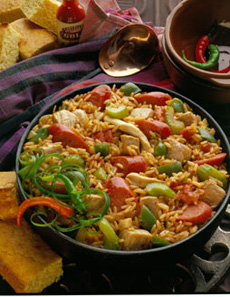
Jambalaya, a Cajun dish adapted from Spanish paella, uses long-grain white rice as a base for a topping of highly-seasoned seafood and meats. Photo courtesy of National Pork Board.
October 2007
Last Updated September 2023
|
 |
Rice: History & Types Of Rice
Page 6: Rice Glossary Terms S ~ Z
This is Page 6 of a six-page article and glossary. Click on the black links below to visit other pages.
This material is copyrighted and cannot be reproduced in whole or in part
without written permission. You are welcome to link to it.
SHAHI RICE or POLOW
Medium-grain Persian rice, originally used by the Shahs of Persia. The rice is also called polow (a Persian word that is the origin of pilaf or it may be a spin on the Hindi word pilao). The quality of polow/pilaf dishes in Iran is vast. Look for recipes for traditional Persian sour cherry and parsley rice dishes. Polow is traditionally served at Iranian weddings. On very splendid occasions it is cooked with a caramelized sugar. Serve with stews, grilled meats, yogurt dips, herbs and cheese, breads and soups.
SHORT-GRAIN RICE or JAPONICA RICE
See grain types.
SPANISH RICE
See calasparra rice. |
|
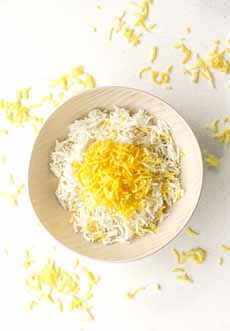
Shahi or polow Persian rice (photo © Uniqop). |
STICKY RICE or SWEET RICE
See glutinous rice.
SUPERFINO RICE
Extra-fine rice.
SUSHI RICE
Refers to a type of medium-grain rice specifically used for sushi. Particular varieties like Calrose, grown in California and used at most U.S. sushi bars, and koshihikari, a premium medium-grain rice preferred in Japan, are two examples.
|
|
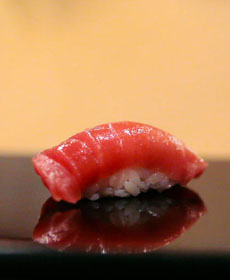
Maguro (tuna) sushi, on a bed of sushi rice (photo © Magnolia Pictures). |
VIALONE NANO RICE
Vialone nano is a “semifino” Italian rice from the Verona area of Italy. Its medium-large, semi-long, rounded grains are capable of absorbing twice their own weight in liquid, making it ideal for creamy risottos—when you’re looking for a soupy base and plump kernels. Cooking time is about 15 minutes, much faster than arborio and carnaroli (which makes the creamiest risotto, which are both designated “superfino,” or extra-fine. It is difficult to overcook vialone nano. The Consortium for the Protection of Vialone Nano Veronese was created in 1979, and the rice has an I.G.P. (Indicazione Geografica Protetta, or Protected Geographic Classification). Vialone Nano is a new rice, created in the 1930s, a hybrid of the Vialone strain; “nano” means dwarf.
|
|
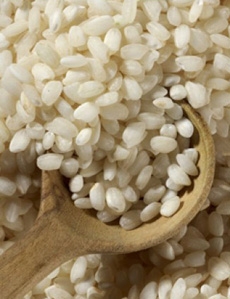
Vialone nano from the Verona area of Italy (photo © Bemboshop). |
WAXY RICE
Also known as sweet rice, the kernels are short and plump, and produce a thick, starchy product when cooked. Waxy rice is most often used as a binder for gravy, sauces, or fillings. See also glutinous rice.
WHITE RICE
Regular-milled white rice, often referred to as “white” or “polished” rice, is the most common form of rice. The outer husk is removed and the layers of bran are milled until the grain is white. While removing the bran and germ makes white rice more tender and delicate, it removes much of the nutrients as well. To compensate, converted rice uses a steam process to retain some of the nutrients.
|
|
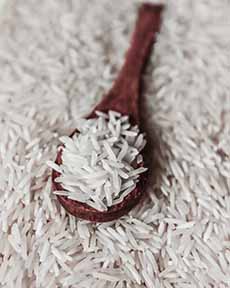
White rice (photo © Maddie Freddy | Pexels). |
WILD RICE
Wild rice is a member of the Poaceae family, genus Zizania; it is a cousin to true rice, the genus Oryza. Like Orzya, it grows in shallow water. Instead of being cultivated, as the name indicates, it grows wild in small lakes and slow-flowing streams. There are four species of wild rice, three native to North America: Northern wild rice (Zizania palustris) from the Great Lakes region (it is the state grain of Minnesota), Wild rice (Zizania aquatica), which grows in the Saint Lawrence River and on the Atlantic and Gulf coasts; and Texas wild rice (Zizania texana), which grows along the San Marcos River in central Texas. The fourth species is native to China, Manchurian wild rice (Zizania latifolia, also called Zizania caduciflora).
|
|
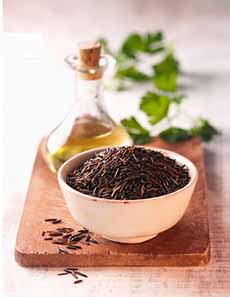
Wild rice (photo © California Wild Rice Advisory Board). |
WHOLE GRAIN
Products made with the whole kernel or grain, which consists of three components: the bran, endosperm, and germ. The bran (outer layer) contains the largest amount of fiber, the endosperm (middle layer) contains mostly protein and carbohydrates along with small amounts of B vitamins, and the germ (inner part) is a rich source of trace minerals, unsaturated fats, B vitamins, antioxidants, and phytochemicals. Determining what is and is not a whole grain can be confusing. For example, brown rice is a whole grain, but light brown rice is not. Read our overview of whole grains for what is a whole grain (including an informative list). The Whole Grains Council offers an optional stamp to identify products that are whole grain.
|
|

The logo of the Whole Grains Council. |
Content researched from:
- CalRice.org
- RiceSelect.com
- PlantCultures.org
|
- USA Rice Federation, USARice.com.
- Other sources
|
For more information about rice, read:
Go To Article Index Above

|










